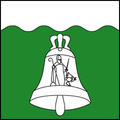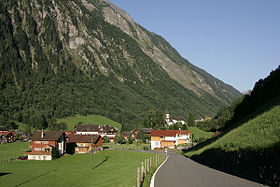Undercutting
| Undercutting | |
|---|---|
| State : |
|
| Canton : |
|
| District : | No district division |
| BFS no. : | 1219 |
| Postal code : | 6465 |
| Coordinates : | 701 574 / 191198 |
| Height : | 995 m above sea level M. |
| Height range : | 964–3295 m above sea level M. |
| Area : | 80.28 km² |
| Residents: | 697 (December 31, 2018) |
| Population density : | 9 inhabitants per km² |
|
Proportion of foreigners : (residents without citizenship ) |
1.8% (December 31, 2,014) |
| Mayor : | Arnold Ambros |
| Website: | www.unterschaechen.ch |
|
Unterschächen with Klausenpassstrasse |
|
| Location of the municipality | |
Unterschächen is a municipality in the canton of Uri in Switzerland .
geography
Unterschächen is located in the rear part of the Urner Schächental valley . In the north the Schächentaler Windgellen ( 2622 m above sea level ), in the east the Klausenpass and in the south Gross Windgallen ( 3187 m above sea level ), the Ruchen and the Schärhörner form distinctive municipal boundaries. The municipality includes the hamlet Urigen ( 1282 m above sea level ), located northwest of the village on the hillside, the hamlet of Schwanden ( 1072 m above sea level ) 1 km east of the village , the scattered settlement Schwandenbergen , Brunni ( 1395 m above sea level) . ) in the Brunnital valley south of Unterschächen and the hamlet of Klausenpass as well as numerous groups of houses, alpine settlements and individual farms.
Only 14 hectares or 0.17% of the municipality is settlement area. More important is the agricultural area with 3062 ha or a share of 38.1%. Most of the municipal area is covered by forest and wood (1034 ha or 12.9%) or unproductive area (water bodies and mountains; 4876 ha or 60.7%).
Unterschächen borders in the north-east on the Schwyzerische community Muotathal , in the east on the Spiringer exclave Urnerboden , in the south on Silenen , in the south-west on Schattdorf , in the west on Spiringen and in the north-west on Bürglen .
population
| Population development | |
|---|---|
| year | Residents |
| 1850 | 475 |
| 1870 | 464 |
| 1880 | 588 |
| 1900 | 619 |
| 1920 | 620 |
| 1960 | 626 |
| 1970 | 665 |
| 1980 | 652 |
| 1990 | 689 |
| 2000 | 764 |
| 2005 | 746 |
The population remained almost stable between 1850 and 1870. After that, it grew strongly until 1900 (1870–1900: + 33.4%). The growth was particularly strong in the 1870s. Apart from small fluctuations in 1910 (585 inhabitants) and 1930 (low of 582 inhabitants), the population always hovered around the 620 inhabitants mark until 1960. Between 1980 and 2000 there was a big surge in growth (1980–2000: + 22.0%). Since then, the population has stagnated again.
languages
The population speaks a highly Alemannic dialect. Almost the entire population speaks German as the everyday language. At the last census in 2000, 99.61% said German, 0.21% Italian and 0.13% Portuguese were their main languages.
Religions - denominations
The population used to be fully members of the Roman Catholic Church. The denominational relationships in 2000 still show the original structure. 95.68% of the people were Catholic, there were also 0.65% Evangelical Reformed Christians and 0.39% non-denominational. 1.96% did not provide any information about their creed.
Origin - nationality
Of the 746 residents at the end of 2005, 740 (99.20%) were Swiss citizens. The few immigrants come from Germany, Austria, Portugal and Sweden. At the 2000 census, 756 people (98.95%) were Swiss citizens; six of them had dual citizenship.
age structure
The community has a high proportion of young people. While the proportion of people under the age of twenty makes up 36.26% of the local population, just under 13% are senior citizens (60 years and older).
The last census in 2000 showed the following age structure:
| Age | 0–6 years | 7-15 years | 16-19 years | 20-29 years | 30–44 years | 45–59 years | 60–79 years | 80 years and more |
| number | 91 | 126 | 60 | 100 | 167 | 121 | 81 | 18th |
| proportion of | 11.91% | 16.49% | 7.85% | 13.09% | 21.86% | 15.84% | 10.60% | 2.36% |
politics
legislative branch
The municipal assembly forms the legislature. It usually meets twice a year.
executive
The seven-member municipal council forms the executive . He works part-time. The current mayor is Arnold Ambros (as of 2017).
economy
In 2005 there were 51 farms offering 138 jobs. Industry and trade employed 7 in 4 workplaces, the service sector in 15 companies 66 people (employment converted to full-time positions). The 2000 census showed 54 agricultural and forestry businesses with 149 employees. The 2001 company census came to 4 industrial and commercial enterprises with 9 and 16 service companies with 87 employees. Of the 371 employed people in Lower Saxony in 2000, only 122 (32.88%) worked in their own municipality. In total, the place offered 143 jobs, of which 122 (85.31%) were occupied by locals.
Most of the 249 commuters do their work in other municipalities in the canton of Uri. Including 106 people in Altdorf, 35 in Schattdorf, 28 in Bürglen, 19 in Spiringen and 14 in Erstfeld. There were only 21 commuters. These came mainly from Spiringen (7 people), Bürglen UR (6) and Schattdorf (3).
Attractions
In the death chapel or ossuary chapel built in 1701 next to the parish church of St. Theodul, the iconographic program of the “ Four Last Things ” is depicted by an unknown artist . It begins with the altarpiece of the “good death” and continues on the ceiling of the choir with Christ as judge, heaven and hell. On the gable side, next to the door, there are two depictions of the poor souls in purgatory . The scenes on the nave walls show examples of the mutual help of the living and the dead from the so-called example literature: The sacrifice of the miner's wife , The bishop's dream , The vision of Maria von Oignies , The mass of Nicholas of Tolentino , Eusebius of Sardinia in the fight against Ostorgus of Sicily and the legend of the grateful dead . What is unusual about the grateful dead is that the dead are depicted as intact as if they had recently died. On the medallions on the ceiling and on the entrance wall, as well as in the stitch caps of the vault, seven paintings with scenes similar to the dance of the dead from around 1701 can be seen. The skeleton of the dead meets the Seven Deadly Sins : superbia (pride), avaritia (greed), luxuria (lust), ira ( anger ), gula ( intemperance ), invidia (envy) and acedia (indolence).
Town twinning
A partnership with the city of Grenchen in the canton of Solothurn has existed since 1968 .
Personalities
- Johannes Vonderach (1916–1994), Bishop of Chur , born in Unterschächen
Web links
- Official website of the community of Unterschächen
- Hans Stadler: Unterschächen. In: Historical Lexicon of Switzerland .
Individual evidence
- ↑ Permanent and non-permanent resident population by year, canton, district, municipality, population type and gender (permanent resident population). In: bfs. admin.ch . Federal Statistical Office (FSO), August 31, 2019, accessed on December 22, 2019 .
- ↑ https://www.pxweb.bfs.admin.ch/Selection.aspx?px_language=de&px_db=px-x-0102020000_201&px_tableid=px-x-0102020000_201\px-x-0102020000_201.px&px_type=PX
- ↑ Hans Georg Wehrens: The dance of death in the Alemannic language area. "I have to do it - and don't know what" . Schnell & Steiner, Regensburg 2012, ISBN 978-3-7954-2563-0 . Pp. 48 and 222ff.






